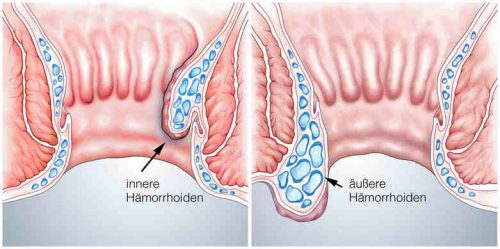Department Piles

piles Introduction
Hemorrhoids are a widespread disease, but nobody talks about it.
What are hemorrhoids?
What are hemorrhoids? Hemorrhoids are varicose vein-like, nodular enlargements of arteries and veins under the lining of the anal canal
Hemorrhoids are nodular enlargements of the rectal vessels, which are supplied with blood at high pressure by a central artery. Normal anal vessels serve to regulate intestinal activity. Stretched rectal vessels are “like varicose veins in the rectum” and cause the intestinal wall to prolapse. Weeping, skin irritation, burning, itching and even bleeding can occur. The external hemorrhoid are called perianal veins in technical jargon. The so-called perianal thrombosis or anal vein thrombosis is an acute, very painful matter, a painful lump in the rectum, which arises suddenly and forces everyone to see a doctor.
What are the causes of hemorrhoids?
The cause of hemorrhoids is not exactly clear. The main cause seems to be the civilized way of life. Modern man sits too much and consumes too little fiber. Muesli, salad, oatmeal, wheat bran are part of a conscious and good diet that not everyone follows. But genetic predispositions can also be the reason for hemorrhoids.
Pictures, before and after pictures about hemorrhoids
Learn more through pictures as well as before-after pictures about hemorrhoids, perianal veins, before and after pictures of hemorrhoids laser surgery (LHPC) and hemorrhoid laser treatment, as well as Perianal vein laser treatment and Perianal thrombosis laser treatment at the HeumarktClinic in Cologne with Dr. Haffner.
What to do with hemorrhoids
Discomfort and Symptoms of Hemorrhoids
Hemorrhoids of any severity often cause bleeding and itching in the anal area. In addition, there are often voiding disorders. Patients with hemorrhoids have to go to the toilet several times in a row and are unable to urinate all at once. Constipation, feeling of pressure, pain are often symptoms. Smearing of the stool is also common, but this is to be distinguished from stool incontinence. Real stool incontinence does not occur with hemorrhoids because the reflexively tense deep sphincter muscles not only prevent the occurrence of hemorrhoids, but also protect against stool incontinence. However, this muscular protection of the deep pelvic floor muscles cannot prevent the disruption of fine continence at the anal edge. The anal insufficiency in the anal entrance then leads to the typical haemorrhoidal symptoms such as weeping. Itching, burning, smearing. Finally, hemorrhoids cause filled so-called perianal veins, which are perceived as “varicose veins of the rectum” or external hemorrhoids. These are problematic because a perianal thrombosis or anal vein thrombosis follows or small tears up to bleeding painful anal tears develop, which then – because of the underlying disease haemorrhoids – heal poorly.
bleeding from the rectum
According to S3 guidelines, the most common sign of hemorrhoids is bleeding from the rectum. The frequency and severity of the bleeding according to the guideline does not follow the above-mentioned staging of hemorrhoids. Bleeding from the rectum occurs first of all with smaller haemorrhoids and – rightly so – alarms patients in the early stages of haemorrhoids. And because no one wants to live with bleeding from the rectum, sanitation – eg laser surgical therapy – is indicated even for minor hemorrhoids if the bleeding or other symptoms are causing it. Bleeding from hemorrhoids, which are arterial vascular conglomerates, are usually bright red, may be little in intensity, but may be very profuse, collapsing bleeding. Because people with strong sphincters can always hold the rectum, the bleeding initially collects in the ampulla of the rectum. Then after accumulation, like blood stool, larger quantities can be emptied. The color is then rather darker red. Perianal veins that bleed during anal tears may also bleed dark red. It is important to know that the first symptom of intestinal and rectal tumors is usually bleeding. Therefore, when bleeding from the rectum, it is imperative to visit a proctologist in Cologne and thus be able to have the fastest type of diagnosis carried out without the need for time-consuming preparations. Only a normal bowel movement at home before the examination plus hygienic cleaning is necessary.
Perianal eczema – perianal inflammation
The permanent irritant toxic skin inflammation on the anus is called perianal eczema. The attentive proctologist always observes whitish-reddish discolored skin, which has wounds and cracks that are many millimeters in size or larger. The per anal skin is swollen, forms stronger folds and skin adherents so-called skin tags. The diagnosis can even be made by the country doctor by visual diagnosis without further examinations: the attentive doctor sees whitish red and coated, sore, wrinkled skin in a field of about 2-6 cm around the rectum. When spreading the anal canal, mucus, oozing, or sometimes smearing of stool can be seen. Some patients always wear cream. If a patient goes to the proctologist with creamtem rectum, then the fact that the patient is dependent on cream speaks for the suspicion of advanced haemorrhoidal disease.
Anal itching, itching and burning in the rectum
The inflamed perianal skin announces and it itches, it burns, it stings the rectum so much that some of them cannot sleep at all. The symptoms of itching, burning, pain and stinging in the rectum are caused by anal insufficiency, because the rectum is not able – insufficiently – to close completely and dry. The irritation of the skin is the same as when you have a bad flu and your nose is constantly running. Although the liquid from the nose is small and clear, it irritates the previously healthy and dry skin massively, makes it red and swollen, painful when touched, constantly burning. A similar thing happens when the rectum does not close completely because of hemorrhoids: it is enough if just a little mucus from the normal, mucous-skin-covered anal canal constantly smears onto the perianal, originally dry skin. The dry, healthy skin in the anal entrance is attacked, damaged by the constantly smearing mucus, inflamed, swollen, which then appears as itching and burning. In order to get itching and burning in the rectum, there is no need for “faecal incontinence”. With a completely normal ability of the rectum to hold the coarse stool, the last 2 cm in the anal entrance can still be insufficient, closing insufficiently if complete wicking through the hemorrhoids that have protruded into the anal canal and above is not possible. Then comes the oozing of mucus and moisture from the normal SLIME skin, which then leads to itching of the outer normal skin, which probably cannot tolerate the mucus in the long run.
incident
Goligher’s staging of hemorrhoids incorrectly suggests that hemorrhoids cause only one problem, the prolapse. Furthermore, this old so-called staging gives the impression that the severity of the haemorrhoidal disease and the symptoms are only related to the degree of the occurrence of internal haemorrhoids. Prolapsing external hemorrhoids, thrombosis from external hemorrhoids, anal insufficiency, disturbance of fine continence, bleeding, wetness and itching as well as skin eczema are not taken into account. Even the S3 guideline in Germany has adopted this old staging and suggests indications for surgery depending on this outdated staging of hemorrhoids. Goligher’s staging of hemorrhoids considers only the occurrence of internal hemorrhoids. In the proctology clinic, however, the patients most often present with a combined occurrence of internal and external hemorrhoids and skin tags, which together form a protruding lump on the anus that can be felt and interfere with anal hygiene and emptying. If the external hemorrhoids – the perianal veins – then thrombosis or the skin tags at the top of the prolapse are constantly irritated, then patients want their gentle and painless removal regardless of whether the internal hemorrhoids are in stage II or III. Up to 90-95% of patients come with the complaint of a “palpable lump on the rectum” if the lump appears as a thrombosed perianal vein. Only about 10% of patients seek help because of protruding hemorrhoids, which are annoying because they should be moved back with a finger from time to time. Skin tags as knots on the anus are a frequent reason for visiting a proctologist. Customers mostly want to desolate skin tags “without surgery” with a laser.
anal tear
Anal tears result either from violent stretching or, without external trauma, from softened, inflamed perianal skin and mucosa. The tears can appear both in the anal entrance as a classic anal tear and micro tears, micro wounds around the rectum. The inflamed skin and the cracks and the wounds are very painful both spontaneously and at the slightest touch. Stagnation of blood in the hemorrhoids and perianal veins inflates the mucous membrane much like air inflates balloons. Then the inflated mucous membrane ruptures just like the balloons when there is a scratchy bowel movement. Inflamed, eczematous perianal skin is less resistant than healthy skin. Therefore, hemorrhoids lead to the anal tear through several channels: on the one hand through skin damage and on the other through the inflated, thin anal skin and mucous membrane. When it comes to anal tears, the HeumarktClinic Proktologie in Cologne does not carry out any traumatizing or sphincter-weakening interventions, which are recommended nationwide by the information sheets in proctology in Germany and could even appear on the surgical program of the best proctologist in Cologne. Because an anal tear is not an independent disease in the above sense, but is the result of hemorrhoids, the triggering hemorrhoids should be treated together with them. And without a cut and without a knife or scissors with laser radiation in the HeumarktClinic proctology in Cologne. In particular, the notching or cutting of the sphincter muscle recommended in the information sheet is not recommended, nor is the cutting out of the tear by the HeumarktClinic Proktologie in Cologne.
Pain in the anus, in the rectum
Hemorrhoids themselves do not hurt! In our private proctology consultations in Cologne, patients often come to us who are surprised when the proctologist reports the findings of prolapsed haemorrhoids, which lead to weeping, inflammation, itching and burning and therefore urgently need invasive treatment. Because hemorrhoids are not painful, they are often tolerated even if they protrude during a bowel movement, even if they have to be pushed back from time to time. Patients get used to the condition of their own rectum because the condition only changes slowly over many years and can be compensated for the most part with the still strong sphincter muscles. It is surprising for the proctologist that many patients do not even notice the eczema, the inflammation of the perianal skin. Many people don’t seem to care that it sometimes itches, but goes away with a “good hemorrhoid ointment”. Some people don’t notice when the inflammation spreads up to the coccyx or the front of the scrotum in men or the vaginal entrance in women. Many people do not perceive the dependency on a haemorrhoid ointment or even cortisone ointment as an illness, “it’s just the skin that scratches a bit” they say.
skin tags
Skin tags are skin tags, flaps of skin in the anal entrance outside the anus, so unlike mucous membrane tags – polyps – in the intestine or in the anal canal. The formation of skin tags results from several factors: it is triggered by prolapse of the mucosa, by microthrombosis of the perianal veins, or by both, and is aggravated by skin irritation during wetting and disturbance of fine continence. Skin tags bother most, especially women, because of the aesthetics, even if they are not painful. If someone presents to the proctology department in Cologne because of severe pain, then 90% of those affected already have severely painful anal tears. As the reader can see from the previous lines, tears do not appear without a reason, but rather due to torn perianal veins, or due to high compensatory tension or damaged, inflamed anal skin due to anal insufficiency and hemorrhoids. Sudden pain and a palpable hemorrhoidal node in the rectum at the same time indicates thrombosis of hemorrhoids or perianal veins.
Anal spasm and continence disorder
Lord’s anal spasm is a classic symptom of hemorrhoids, which in the days of the inventor was still treated with the Lord anal dilator. Even today there are anal dilators, which are ordered when the rectum is so tense that the tension leads to severe pain on the one hand, sometimes at night – called proctalgia fugax – on the other hand to disruption of rectal emptying. In short, the rectum cannot open properly and thus empty properly. One may ask, why should both anal spasm and anal insufficiency be a feature of hemorrhoids? Should the rectum muscles be weak and insufficiency or too cramped and too? The explanation for this is as follows: We are not talking about a sphincter in proctology in Cologne, but a sphinctern. The sphincters are didactically divided into two main muscle groups that have different responsibilities and functions in terms of continence.
Anal insufficiency = disturbance of fine continence
According to the S3 guideline of the German specialist societies for proctology and colo-proctology (page 48 of lit. 2) prolapsing hemorrhoids set a link from your homepage to Fewo-von-Privat.de the fine continence may be disturbed. What does that mean? Is there incontinence, fecal incontinence due to hemorrhoids? The answer is: yes. According to the wording of the S3 guideline, prolapsed hemorrhoids lead to a mucous, even feculent secretion, which initially only manifests itself as weeping but later as stool soiling and can then lead to stool-soiled laundry [8]. The perianal skin is permanently irritated by constant wetting. It is a bit incomprehensible that anal hygiene and a dry and non-smearing anal entrance is not a matter of course, that traces of stool on the underwear of many are not an indication that something is wrong with the rectum. The term “anal insufficiency” – disturbance of fine continence – is a “foreign word” in the general public, which “does not concern me” because “I can hold my chair after all”.
Perianal thrombosis – anal thrombosis
When the accumulated blood clogs in the stretched out veins at the edge of the anal, this occurs Perianal thrombosis or anal vein thrombosis.
It is a painful bump on the edge of the anus. Sitting and defecating are painful. The perianal thromboses often burst, then they also bleed. Pain, palpable, unclear knots, bleeding then urgently lead the patient to the doctor. It is important to know that the thrombosis at the edge of the anal area is only the externally visible sign of the internal, real haemorrhoids. The English-speaking world differentiates between external and internal hemorrhoids, which present themselves as two components of hemorrhoidal disease. Without internal hemorrhoids, external hemorrhoids do not form and thrombosis of the perianal veins at the anal entrance does not occur. Sometimes thrombosis of both internal and external hemorrhoids occurs, which can be extremely painful and require urgent proctological therapy.
What treatments for hemorrhoids and thrombosis?
If the anus itches, burns, itches, smears or bleeds, then you should have the rectum examined by a specialist in proctology in Cologne, proctologist, proctologist, to have the haemorrhoids basic diagnosis and cancer screening done. After the examination, one can consult conservative methods such as rubber band ligation, sclerotherapy, freezing and operational methods such as HAL method, THD, RAR methods, submucosal ligation, ligature excision. The description of the possible therapies starts with the laser therapy in our proctology department in Cologne, because according to our motto “the laser is the best ointment”, so we start with that. With laser technology, the laser closure of hemorrhoids is possible almost without surgical wounds and without surgical pain.
The LHPC – Laser Hemorrhoids Plastic Surgery
This is how the new laser method of hemorrhoid surgery came about as LHPC, Laser Hemorrhoid Plastic Surgery in Cologne, which has become the standard therapy for all types and stages of hemorrhoids in our practice.
Advantages of the LHPC
No cuts – no cuts – hardly any pain
Sphincter strengthened instead of weakened
Defecation better than before
Continence stronger than before
Immediate sociability
Before the appointment for the laser haemorrhoids plastic surgery, a preliminary examination is carried out using ultrasound, in which the entire network of arteries and veins is displayed and your symptoms are clarified. Hemorrhoids Laser Plastic Surgery takes place on an outpatient basis under a short general anesthetic or twilight sleep. Local anesthesia with tumescent technique is only sufficient for small hemorrhoids.
HAL, THD and RAR methods
These methods are proctological-plastic special suture techniques. Common basis of the HAL, RAR and THD methods is that the hemorrhoids are fed by large arteries and if these arteries are ligated then the hemorrhoids should be less blood supplied and regress. With the HAL method, a single artery is usually selectively located with a Doppler ultrasound probe and then blocked by placing a ligature. In the THD method, these sutures, which are tied off the arteries, are placed in a circular manner in the entire inner circumference of the rectum. The goal is the THD – as the name suggests – the transanal hemorrhoid desarterilization, i.e. the ligation of all important main vessels of hemorrhoids. According to this, the hemorrhoids should form back in a circular fashion. With the RAR method, the hemorrhoids are initially prevented, similar to the HAL method. After the ligation of the main artery, the intervention is not ended, but the hemorrhoid mass is tied up with further ligatures and the mucous membrane is lifted and tightened. The RAR ligation and tightening involves one ray of hemorrhoids from the – usually four – main ray of hemorrhoids. In the HeumarktClinic Proktologie in Cologne, all plastic proctological suture techniques are applied with decades of experience and success. In our experience, the methods are good, but combined with additional laser irradiation of the hemorrhoidal masses, they are much more effective. Conclusion: HALRAR-THD with laser is the most effective and gentle treatment alternative available in proctology with immediate ability to sit, walk and chair. There are no cuts and no lacerations, so the risks and complications are reduced to the possible.
| Unit 1 | Time |
| Sunday, Tuesday | 9 AM To 1 PM |
| Monday, Wednesday | 2 PM to 4 PM |
| Unit 2 | Time |
| Sunday, Tuesday | 9 AM To 1 PM |
| Monday, Wednesday | 2 PM to 4 PM |
Specialists in this Department
- 9876543210
- [email protected]
- 9876543210
- [email protected]
- 9876543210
- [email protected]
- 9876543210
- [email protected]




